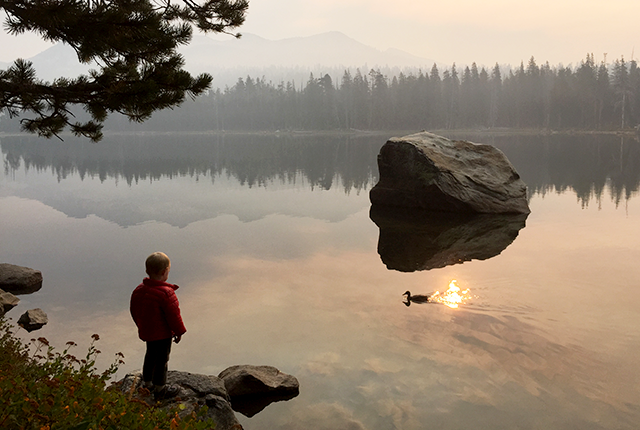
Wildfire smoke poses risks for fetuses, young kids
Exposure to wildfire smoke can result in low birth weight, premature births and developmental delays, studies show.Media Contact: Barbara Clements - bac60@uw.edu, 253-740-5043

As wildfire smoke swirls around Washington state, the health risks for two populations often get overlooked, a UW Medicine pediatrician says.
Pregnant women and small children are particularly vulnerable to the smoke’s gaseous chemical compounds and the particles whose diameter can be 30 times smaller than that of a human hair.
Children “are vulnerable because, pound for pound, they take in more air on a per-kilogram basis compared to adults,” said Dr. Catherine Karr, professor of pediatrics at the UW School of Medicine. She also directs the Environmental Protection Agency-funded Northwest Pediatric Environmental Health Specialty Unit at the University of Washington.
Karr added that the health implications for pregnant women and fetuses also are now being appreciated and studied.
"As an environmental epidemiologist and a pediatrician, I am struck by the evolving evidence for not just short-term effects of wildfire smoke, but potential longer-term health effects such as risk of a delivering a low birth weight or premature infant, or reduced lung-function growth in kids,” she said.
Smoke’s toxic effect on growing brains may manifest as learning and behavioral problems in children. Karr was senior author of a 2022 study that examined maternal exposure to air pollution during pregnancy and neurodevelopmental outcomes. Children whose mothers experienced higher nitrogen dioxide exposure during pregnancy, particularly in the first and second trimesters, were more likely to have behavioral problems in early childhood, the investigators found.
Researchers also reported that higher exposures to small-particle air pollution in children 2 to 4 years old was associated with poorer child behavioral functioning and cognitive performance. While this research focused on routine sources of particulate matter in outdoor air of communities, PM2.5 is an important component of wildfire smoke pollution as well.
The study used data gathered from 1,967 mothers recruited during their pregnancies in six cities: Memphis, Tennessee; Minneapolis; Rochester, New York; Yakima, Washington, and Seattle.
“This study reinforces the unique vulnerability of children to air pollution — both in fetal life, where major organ development and function occurs, as well as into childhood, when those processes continue,” Karr said in a news release on the 2022 paper.
During a pregnancy, particles and gases from polluted air can cause an inflammatory response and other biological consequences in the mother that can be transmitted to the fetus via the bloodstream and placenta.
Regarding air pollution and brain development, In children, the smallest of particles in smoke can access the brain directly through the olfactory bulb, a smell-sensing organ that lies deep in the nasal cavity, she said.
“There is some suggestive evidence that wildfire smoke particulate matter may be a little more potent than general ambient particulate-matter air pollution,” Karr said. “The combination of particulate and gases form a toxic airborne soup that children breathe.”
With the increased occurrence and severity of wildfire smoke, in the Northwest and other parts of the United States, Karr encourages pregnant women and parents of young children to strategize as the wildfire season draws near.
First, be aware of the Air Quality Index, or AQI, which can be monitored via an app at Airnow.gov which provides information for locations nationwide. Locally, the Puget Sound Clean Air Agency website also carries current and upcoming air-quality forecasts.
AQI color coding is easy to understand: Green is a good air day and anything in the yellow or orange range merits increased caution. At the yellow and orange stages, kids and pregnant women should reduce exposures by modifying activities and staying indoors, Karr said.
To ensure indoor air is healthy when wildfire smoke is present, close doors and windows and consider investing in an air purifier or making your own. For home centralized HVAC systems, install a MERV-13 rated or higher number filter.
If you need to spend short periods outside, Karr advised, use an N95 type respirator. While driving, switch the fan air to recirculate. More information on protecting children from wildfire smoke can by found on the Northwest Pediatric Environmental Health Specialty Unit or NW PEHSU webpages.
Download broadcast-ready soundbites featuring Karr explaining how wildfire smoke threatens children, and more tips to reduce their exposure.
For details about UW Medicine, please visit https://uwmedicine.org/about.